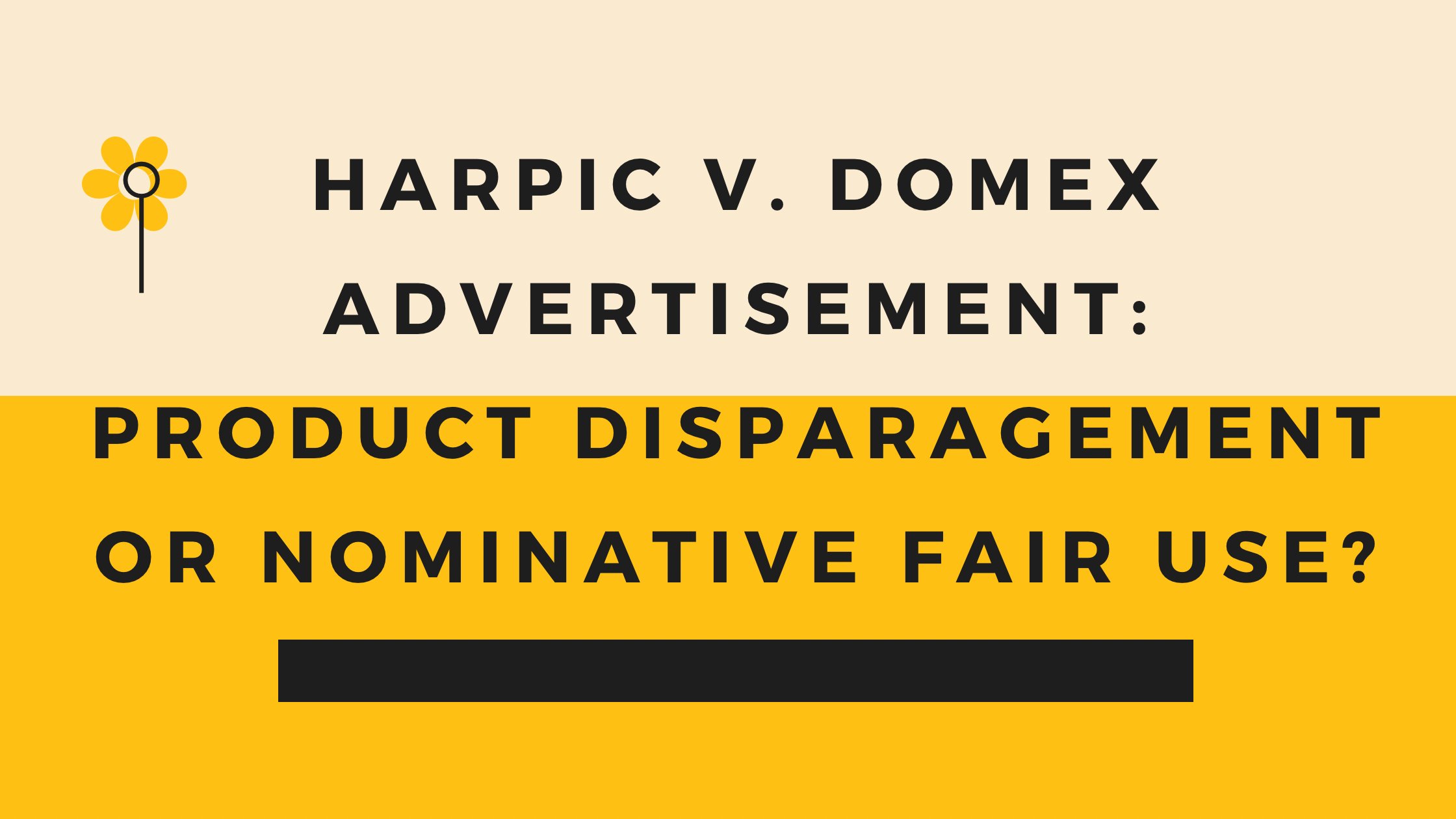HARPIC V. DOMEX ADVERTISEMENT: PRODUCT DISPARAGEMENT, OR NOMINATIVE FAIR USE?
Advertisers while advertising should ensure that through their advertising the brand value and image of other brands should not be affected. In the present case, Domex, could have reflected upon the special characteristic of i.e., it can improve toilet odour without referring to the brand name of the competitor i.e., Harpic. Advertising is an important strategy for a company to sell its products to the customer. Advertising generates awareness about a particular product among the masses and the reaction of the masses decides the fate of the product.

INTRODUCTION
Advertising is an important strategy for a company to sell its products to the customer. Advertising generates awareness about a particular product among the masses and the reaction of the masses decides the fate of the product.
To increase their sales, often companies indulge themselves in comparative advertising. Comparative advertising is defined as a strategy where one product is being compared with its competitor in order to tell the masses why the former is superior to the latter.
Recently, in a new ad campaign launched by Domex, a Hindustan Unilever brand, has openly compared itself to Reckitt Benckiser’s toilet cleaner brand ‘Harpic’. Reckitt Benckiser has already approached the Delhi High Court and an interim injunction has been granted.
The two main types of comparative advertising are Puffery and disparagement. When a company makes exaggerated claims about its own product in order to persuade the masses that their product is superior to its competitors, is known as puffery. When the same thing is done by smudging the image of a distinguishable product of the competitor is known as disparagement. The Delhi High Court in the case of Colgate Palmolive (India) Ltd. v. Anchor Health and Beauty Care Pvt. Ltd. Observed that when an advertisement pulls up the products of others in order to increase the popularity of the product among the masses is called disparagement.
The Delhi High Court in the case of PepsiCo. Inc. v. Hindustan Coca Cola Ltd outlined following things while determining disparagement:
-
The commercial intent of the advertisers and the target which they want to achieve through promotion.
-
Most important thing is the nature of the commercial. It will amount to disparaging if any product tries to lambaste the other and not when the former is simply demonstrating its product without belittling the other.
-
The commercial's message is attempting to spread through advertising.
If above tests are applied to the present case, it is evident that the Hindustan Unilever brand Domex is disparaging the brand image of Harpic of Reckitt Benckiser. It does so by directly comparing itself with Harpic and then questioning its efficacy if removing toilet odour.
Nominative fair use of a trademark
It is a legal doctrine that can be used as a defence in some types of trademark infringement cases. The Madras High Court in the case of Consim Info Pvt. Ltd v. Google India Pvt. Ltd, any unauthorized advertisement will be termed as normative fair use , if it passes following test –
-
Without the use of the trademark, the product or service in question must be difficult to identify.
-
When using the mark, the user must do nothing that suggests sponsorship or endorsement by the trademark owner.
-
Only that much mark should be used which is reasonably necessary to identify the product.
There is definitely no suggestion of sponsorship or endorsement in the current advertisement. However the main aim of Domex to persuade its masses about its odour control technology can be achieved without comparing itself with its counterpart Harpic.
Therefore the defence of normative fair use is not available to Hindustan Unilever. In the case of Havells v. Amritanshu, however the Delhi High Court held that, for an advertisement to qualify as nominative fair use, may highlight just a particular quality of the product that differentiates it from that of a competitor as long as the comparison is true and accurate.
The defence of honest and true representation of facts can be taken by Hindustan Unilever however it is also subjected to the provision of fair trade practice under section 30(1).of Trade Marks Act, 1999.
As far as the current case is concerned, the Delhi High Court has granted interim injunction against one of the print advertisements in which Harpic was demeaned till the time the defendant files its reply.
The Court cited two cases i.e., Dabur India v. Colortek Meghalaya Pvt. Ltd. and Colgate and Anr. v. Hindustan Unilever Ltd. Observed that since comparative advertisements form a part of commercial speech guaranteed under Article 19(1) (a) of the Indian Constitution, it takes a negative form, if used to defame a brand, then it amounts to disparagement. Comparative advertising is not illegal but should be used wisely.
CONCLUSION
Advertisers while advertising should ensure that through their advertising the brand value and image of other brands should not be affected. In the present case, Domex, could have reflected upon the special characteristic of i.e., it can improve toilet odour without referring to the brand name of the competitor i.e., Harpic.
WRITTEN BY:
Rupam Banerjee.












